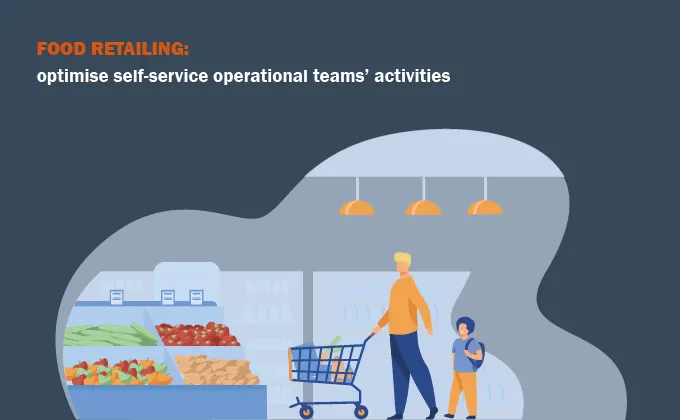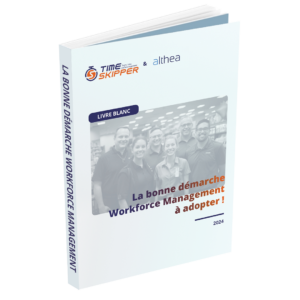As we enter autumn 2021, while business volumes in food retailing are encouraging, the economic equation is not all rosy. Indeed, price inflation is looming, competition, particularly from hard discounters, is increasing, and the increase in distribution channels is causing brands’ operational costs to soar. In addition, the human aspect within teams is complex. The pandemic required huge investment, but also employees had to adapt. The challenge now is to retain them and enable them to evolve.
Tackling this multi-faceted problem means activating three levers simultaneously to find new sources of productivity:
- better knowledge of the teams’ workload
- rigorous, motivating, and inspiring management that’s in touch with the field
- precision logistics optimisation
A considerable feat, but not impossible… demonstration!
1st LEVER: SALE POINT WORKLOAD MANAGEMENT
It’s a fact: activity in points of sale is increasingly diversified. Teams must be flexible and have multiple skills to deal with the most urgent, mandatory and priority… In short, the customer must be served quickly and well… whatever the cost!
This requirement, however, presumes the ability to orchestrate employees’ activities. By this, we mean estimating and correctly distributing the workload, i.e., the volume of working hours linked to the tasks carried out within the teams. This is a significant challenge, and achieving it in this context has become as complex as it is vital, especially since, to be controlled appropriately, the workload must be managed over three scopes:
1) Budget steering
The first step is to simulate the volume of working hours in advance, on a monthly or annual basis. The exercise consists of allocating the right number of people to the different departments of teams to cover a forecast workload, considering absences due to holidays. This way, the teams are sized to meet operational needs.
Ideally, the forecasted workload should serve as a basis for the finance departments to draw up the budget and help the HR departments to feed the applications that generate the time schedules.
2) Operational management
While managing a budget to size the target team in advance by determining the ideal number of people, the challenge of operational management regarding the workload is somewhat different. Indeed, managers must ask themselves if they are leading the team efficiently daily, optimising task distribution between employees according to their skills, and in the fairest possible way.
The workload is recalculated daily with more precise data, for example, the volume of parcels delivered to be put on the shelf. The manager can then distribute the workload in the best possible way, considering possible contingencies, such as an employee’s unexpected absence or a delay in delivery. After distributing the workload, the manager can say whether they have free hours to carry out other tasks or, for example, back up the Drive-in team if they don’t have time to prepare the orders.
3) “Real-time” steering
To top it all off, dynamic management is essential for e-commerce channels such as Click and Collect, Drive-in or home delivery. It’s crucial to meet demand and open delivery slots, whatever the channel. The challenge consists not only in knowing and calculating the workload linked to the preparation of each order but also in being able to say in real-time if there is enough time to prepare it... In this respect, you may start to understand how 41.2% of additional internet orders in 2020, for food alone, has been a challenge for the teams!
To orchestrate the workload over the three budget cycles, operational on D-1 and in real-time, it’s highly recommended to rely on a dedicated solution!
2nd LEVER: RIGOROUS ON-SITE MANAGEMENT
Team involvement is one of the major challenges for shop operations to be completed successfully and is mainly based on managerial know-how. Indeed, each employee and their managers need to understand their contribution to the overall objective by considering their personal, department, team, and shop involvement. Giving meaning, in addition to informing, training, and leading his team, is what a motivating and inspiring manager in food retail is meant to do. And only then can you introduce the teams to the flexibility and versatility, depending on the store’s structure.
Let’s get with the times! Digital and logistical solutions exist, such as tablets or all types of devices that allow information to be received directly on the field. Equipping employees with these tools will enable them to be much more independent, efficient, and even productive… so why not?
Let us also bear in mind the age-old but oh so essential saying, “Retail is detail”. Coordinating and maintaining the right people and the workload daily, as well as ensuring that the work is carried out properly and that the overall quality of the shop is maintained, requires constant attention to detail for every task! This way, the result is done correctly and even better.
1 the workload, once distributed, is compared with the attendance hours of the employees.
As far as management is concerned, its role is to provide the means, independence, and confidence to the managers so that they pass on good practices to the employees. Therefore, aligned with the point-of-sale strategy, the employees work in the same direction: quality.
Once again, an activity management tool is essential, but this time for managerial efficiency!
3rd: THE STORE’S LOGISTIC CHALLENGE
The challenge is to offer linear optimisation in line with inbound logistics. In this respect, the scope of operational disorder looms over points of sale every day. The task’s difficulty is linked to the interdependence between warehouse logistics and store efficiency.
In the first instance, finding the right rhythm for deliveries and ordering the correct number of products is key. That said, how the pallets are prepared is also essential. For example, it’s better to structure them with similar products, to organise the store according to the main categories. This reduces hands-on operations, such as splitting products into separate shelves, which wastes time!
On the other hand, while the supply management tool gives you the right quantities of products to be delivered at the right time, optimising the shelf space and displays is also critical to guarantee operational efficiency in the store. The difficulty lies in determining the best match between the sales volume and shelf capacity to limit the shelves being restocked during the day. This has a double benefit: it avoids stock-outs and saves time by reducing the number of untimely back-and-forths to the stockroom!
Therefore, in-store logistical efficiency requires the integration of all these skills as well as coordination with upstream logistics. In this respect, it’s essential to optimise simultaneously:
- Just-in-time delivery for fast-moving products to ensure store supply
- Palletising and delivery in line with the store’s layout.
Ultimately, optimising Supply and Merchandising is part of a continuous improvement process, the challenges of which are difficult to overcome: the aim is to find the right balance to maximise value both in the store and on the logistics platform.
An activity management tool allows you to identify sources of productivity by trade, department, and task in the store… and ultimately optimise the entire chain from logistics to store operations.
Timeskipper is the platform for optimising and managing all the activities of your point-of-sale teams.
Helping retailers implement the three levers of success linked to operational teams’ productivity:
1) The solid know-how in building time and task repositories and the tool means you can easily manage the workload.
2) Expert in managerial support, the platform helps managers communicate relevant information at the right time: give perspective on business forecasts, distribute the workload fairly and make each employee accountable.
3) The measurement system shows the exact time spent on each task and makes it possible to measure productivity with which the logistics teams can serve the points of sale at any time.
To sum up, by relying on Timeskipper’s business expertise, you can manage and optimise multiple stores with different organisational methods, maximise the efficiency of inbound logistics, and set up a continuous improvement system for the benefit of the whole store!
Pour en savoir plus, demandez une démonstration en ligne !






